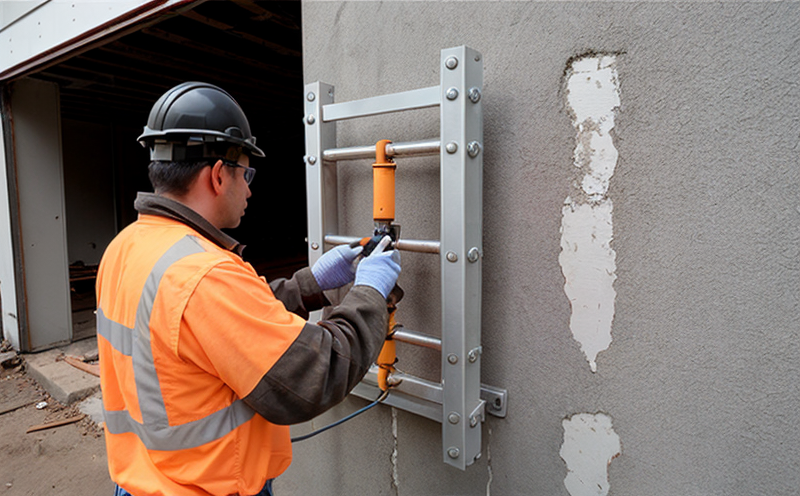Structural crack monitoring inspection
The structural crack monitoring inspection is a critical process in the construction and building sectors aimed at ensuring the integrity of buildings by identifying, assessing, and managing cracks that may arise during or after construction. Cracks can occur due to various reasons such as material fatigue, environmental factors, design flaws, or external loading conditions. This service is essential for maintaining safety standards and compliance with regulatory requirements.
Crack monitoring involves the systematic observation of crack formation, growth, and closure using non-destructive testing (NDT) techniques. These inspections are crucial in detecting early signs of structural deterioration that could lead to catastrophic failures if left unaddressed. The inspection process typically includes:
- Field observations by experienced inspectors
- Use of advanced imaging technologies like thermography and ultrasonic testing
- Data collection using crack monitoring systems
- Analysis of collected data to determine the nature, location, and extent of cracks
The primary goal is to provide accurate and reliable information that helps in decision-making regarding maintenance or repair actions. This service ensures that buildings meet safety standards and comply with local building codes and regulations.
| Inspection Method | Description |
|---|---|
| Visual Inspection | A detailed visual examination of the structure to identify visible cracks. |
| Infrared Thermography | An imaging technique that detects temperature differences in the structure, which can indicate crack locations or moisture intrusion. |
| Ultrasonic Testing | A non-destructive testing method used to evaluate material thickness and detect internal defects. |
The data collected during these inspections is crucial for understanding the behavior of structures under different loading conditions. This information can be used to refine design practices, improve building codes, and enhance safety standards in future projects.
Furthermore, regular crack monitoring helps in identifying potential problem areas early on, allowing for timely interventions that prevent minor issues from escalating into major structural failures. This proactive approach not only enhances the longevity of buildings but also reduces long-term maintenance costs.
Industry Applications
The application of structural crack monitoring is widespread across various industries, including:
- Commercial and residential construction
- Infrastructure projects such as bridges and tunnels
- Industrial facilities like factories and warehouses
- Museum and historical preservation sites
In commercial and residential construction, crack monitoring ensures that buildings are safe for occupancy. For infrastructure projects, it helps in maintaining the integrity of critical structures. In industrial settings, this service is vital for preventing accidents and ensuring compliance with safety standards. At historical sites, it allows for the preservation of heritage structures without compromising their structural integrity.
The use of advanced technologies such as IoT sensors and AI algorithms enhances the accuracy and efficiency of crack monitoring processes. These tools provide real-time data that can be analyzed to predict potential issues before they become critical problems. This proactive approach is particularly beneficial in large-scale projects where downtime or delays could have significant financial impacts.
By integrating structural crack monitoring into routine maintenance schedules, organizations can significantly reduce the risk of unexpected failures and associated costs. It also promotes a culture of continuous improvement by encouraging regular evaluation and enhancement of construction practices and materials.
Why Choose This Test
Selecting structural crack monitoring as part of your quality assurance program offers several advantages:
- Precision and Reliability: Utilizing advanced NDT techniques ensures precise detection and measurement of cracks.
- Data-Driven Decision Making: Comprehensive data collection allows for informed decisions regarding maintenance or repair actions.
- Cost Efficiency: Early identification of issues can prevent costly repairs down the line by addressing problems before they worsen.
- Safety Compliance: Ensures that buildings meet safety standards and comply with local regulations, reducing legal risks.
- Enhanced Reputation: Demonstrates a commitment to quality and safety, enhancing your organization's reputation in the industry.
- Sustainability: By extending the lifespan of structures through timely interventions, this service contributes to sustainable practices.
The reliability and accuracy provided by structural crack monitoring make it an indispensable tool for any construction or building inspection project. It ensures that buildings are not only safe but also durable and cost-effective in terms of maintenance and operation.
Use Cases and Application Examples
This section provides a detailed look at how structural crack monitoring is applied in various scenarios:
| Scenario | Description |
|---|---|
| New Construction Inspection | Detecting and addressing cracks during the initial stages of construction ensures that buildings are built to high standards. |
| Structural Rehabilitation | Evaluating existing structures for signs of wear and tear to determine appropriate rehabilitation strategies. |
| Maintenance Checks | Regular inspections help in identifying cracks that may have formed over time due to environmental factors or age. |
| Historical Preservation | Monitoring heritage buildings for signs of deterioration while ensuring minimal intervention. |
In each scenario, the goal is to ensure that structures remain safe and compliant with relevant standards. By implementing structural crack monitoring, organizations can achieve these objectives effectively and efficiently.





